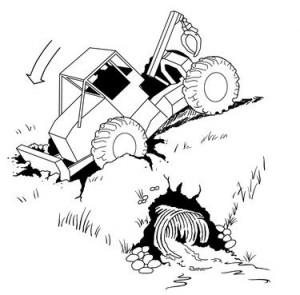BACKGROUND: On a clear, dry, summer day in the South, an equipment operator was moving a skidder from one end of an old, abandoned woodyard to another. The terrain was flat, and the skidder operator was following an existing, old road.
PERSONAL CHARACTERISTICS: The 55-year-old skidder operator had been employed in the logging business for approximately 35 years, and he was considered fully trained for the job. It is not known whether he was wearing a seatbelt.
UNSAFE CONDITIONS: The old road on the woodyard had not been used for approximately 10 years. The skidder operator failed to inspect the road, and he did not look at the culvert that was underneath one section of the road, so he did not notice that the culvert had rusted. The bands connecting the culvert sections were completely rusted through. Additionally, the soil around the culvert had washed out and left a void under the road.
ACCIDENT: When the skidder moved over the rusted culvert, the soil collapsed, and the front end of the skidder dropped approximately five feet down into hole made by the collapsed section.
INJURY: Fortunately, the skidder operator was not injured, and the machine was not damaged significantly.
RECOMMENDATIONS FOR CORRECTION:
• Inspect old culverts and roads prior to use.
• If a section of a road is unsafe and will not be repaired immediately, block it off, close it, and otherwise mark it with barriers, so that no one can be injured. (This road has now been closed, with a fence and barriers placed on each side.)
• Ensure that all equipment operators always wear seat belts when the machine is moving.
 Courtesy of the Forest Resources Association: https://www.forestresources.org/page.asp?content=startpage&g=FRA
Courtesy of the Forest Resources Association: https://www.forestresources.org/page.asp?content=startpage&g=FRA
